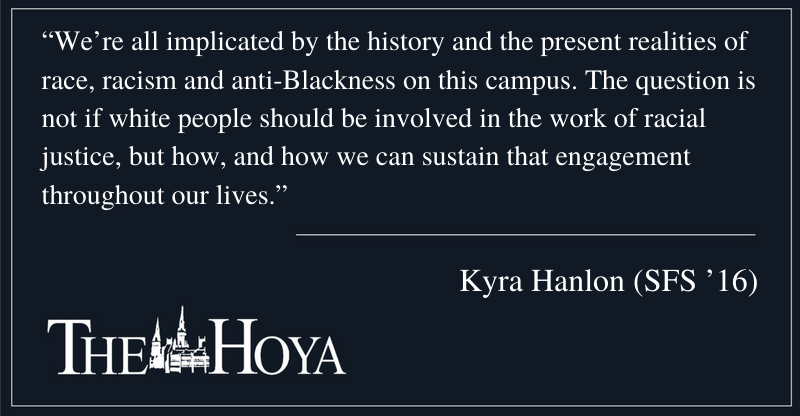As we approach the end of Black History Month, I ask my fellow white colleagues as well as white students to consider how they are participating in the work of racial justice.
We’re all implicated by the history and the present realities of race, racism and anti-Blackness on this campus. The question is not if white people should be involved in the work of racial justice, but how, and how we can sustain that engagement throughout our lives.
As a staff member and graduate of Georgetown University, I’ve found the Ignatian pedagogical paradigm provides insight into the question of how I show up for racial justice through its five parts: context, experience, reflection, action and evaluation.
The first part of the paradigm is context. In other words: white people, do your homework. Starting with context allows us to discover what we don’t know about race and to question what we think we do know. We often hear from students of color that it is exhausting to educate their peers, faculty and staff — so research on your own rather than asking a person of color to explain it to you. Black History Month can be a catalyst because there are so many opportunities for dialogue about race — specifically Blackness — happening this time of year. Read the report of the Working Group on Slavery, Memory, and Reconciliation, and learn about Georgetown’s history of the enslavement of Black persons and the 272 enslaved people sold by the Maryland Province of the Society of Jesus in 1838 to financially sustain the university. Check out books designed to help White folks educate themselves without using the labor and time of people of color. Attend some of the Black History Month events on campus and follow activists in Washington, D.C., to generate more questions for yourself. Continue to deepen your understanding of racial justice from intersectional frameworks.
After context comes experience, in which we heighten our awareness of our own embodied experience and the experiences of others through close observation. Be present in your environment and actively pay attention to what is happening around you, with a focus on race. As a white person, noticing race and racialized interactions might feel uncomfortable, but we cannot see racism if we don’t see race. Maybe you notice one of your Black classmates is being asked to speak “on behalf” of their race. Maybe you notice you’re the one asking. Part of being human is making mistakes, and part of being white is recognizing we live in a world that was socially constructed to protect us from accountability when we make those mistakes. Bringing our whole self and our full attention to our experiences better equips us to notice when our actions do not work toward a more just future.
Reflection is how we make meaning and generate insight from our experience. Deep learning requires honesty, accountability and critical reflection to transform problematic behaviors and beliefs. Because difficult emotions may surface in this stage, guilt can sometimes keep us in a pattern of ruminating rather than reflecting. When I find myself slipping into feelings of guilt, I remind myself that guilt is not particularly productive or sustainable, and that perfectionism reinforces white supremacy culture and the status quo. Reflection helps us openly address our feelings, separate intent from impact, and move forward into deeper commitments to racial justice.
Commitment leads us to continued action. We must take the meaning we’ve developed from reflection and act in more skilled and informed ways. The complexity of the work demands stamina — it’s not an excuse to disengage. Action can take on myriad forms: check out Rhonda Magee’s new book and do “The Inner Work of Racial Justice”; be an effective accomplice; if you’re staff, attend an Administrators for Racial Justice meeting. Then, evaluate your efforts and begin the cycle all over again by entering into new experiences that push you out of your comfort zone and into uncomfortable, necessary and urgent work.
Black History Month is an annual reminder to white folks to be accomplices in the work of racial justice and engage all five components of Ignatian pedagogy. February shouldn’t be the only time you think about your commitments to racial justice, but it can help you build momentum and form habits to sustain engagement. So I ask you in the spirit of shared inquiry, today and every day: How will you be an accomplice for racial justice?
Kyra Hanlon (SFS ’16) is the assistant director of immersion programs at Georgetown University.














